|
|
 |
|
Calanoida ( Order ) |
|
|
|
Eucalanoidea ( Superfamily ) |
|
|
|
Eucalanidae ( Family ) |
|
|
|
Subeucalanus ( Genus ) |
|
|
| |
Subeucalanus longiceps (Matthews, 1925) (F,M) | |
| | | | | | | Syn.: | Eucalanus longiceps L.H. Matthews, 1925 (p.127, figs.F,M); Farran, 1929 (p.218, fig.F); Sewell, 1929 (p.50, Rem.); Vervoort, 1946 (p.103, Rem.); 1957 (p.33, Rem.); Senô & al., 1963 (p.6, figs.F); De Decker & Mombeck, 1964 (p.12); De Decker, 1968 (p.45); Ramirez, 1969 (p.43, figs.F); Bradford, 1972 (p.34, figs.F,M); Fleminger, 1973 (p.969, 978, 982, 999, fig.F); Björnberg, 1973 (p.297, 386); Geletin, 1976 (p.91, Rem.); Arashkevich, 1978 (p.118, Table: diets); Björnberg & al., 1981 (p.619, figs.F,M); De Decker, 1984 (p.315); Baessa de Aguiar, 1988 (1990) (p.180, figs.F,M, Rem.F,M); Ward, 1989 (tab.2); Atkinson & al., 1990 (tab.1); Santos & Ramirez, 1991 (p.79); Baessa De Aguiar, 1991 (1993) (p.106); Razouls, 1994 (p.38, figs.F,M); Voronina & Maslennikov, 1994 (p.632, fig.1); Mazzocchi & al., 1995 (p.121, figs.F, Rem.); Errhif & al., 1997 (p.422); Onishchik, 1999 (p.76, figs.2); Atkinson & Sinclair, 2000 (p.46, 50, 51, 53, 55, zonal distribution); Pakhomov & al., 2000 (p.1663, Table 2, transect Cape Town-SANAE antarctic base); Chiba & al., 2001 (p.95, tab.4); Hunt, 2004 (p.1, 47, Table 3.2); Lee D.B. & al., 2013 (p.1215, Table 1, abundance, composition);
Eucalanus acus Farran, 1929 (p.207, 218, figs.F); Hardy & Gunther, 1935 (1936) (p.139, Rem.); Bary, 1959 (p.14, Fig.5, Table 4, correlation T-S): Pakhomov & al., 2000 (p.1663, Table 2, transect Cape Town-SANAE antarctic base);
? E. attenuatus : With, 1915 (p.52);
Euchaeta longiceps : Hunt & al., 2001 (p.374, tab.1: lapsus calami)
Eucalanus longipes : Perissinotto, 1989 (p.505, Table 2, 3, abundance, diurnal variation); | | | | Ref.: | | | Geletin, 1976 (p.91); Bradford-Grieve, 1994 (p.87, 88, figs.F,M, Rem., fig.100); Bradford-Grieve & al., 1999 (p.878, 912, figs.F,M); Goetze, 2003 (p.2322 & suiv.); | 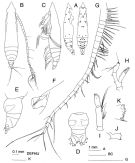 issued from : J.M. Bradford-Grieve in The Marine Fauna of New Zealand: Pelagic Calanoid Copepoda. National Institute of Water and Atmospheric Research (NIWA). New Zealand Oceanographic Institute Memoir, 102, 1994. [p.75, Fig.40]. Female (from Fleminger, 1973, p.985, Fig.9. As Eucalanus longiceps): A, dorsal and lateral pattern of integumental organs (black point = sites occuring at 100% frequency, triangle are sites which are also visible in lateral view but which are assigned to dorsal sets). Female from SE New Zealand): B, habitus (dorsal); C, idem (lateral left side); D, genital segment (dorsal); E, idem (lateral); F, rostrum (lateral view); G, A1; H, A2; I, Md (mandibular palp); J, Md (mandibular blade); K, Md (distal part of mandibular blade).
|
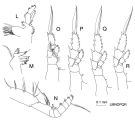 issued from : J.M. Bradford-Grieve in The Marine Fauna of New Zealand: Pelagic Calanoid Copepoda. National Institute of Water and Atmospheric Research (NIWA). New Zealand Oceanographic Institute Memoir, 102, 1994. [p.76, Fig.40 (continuation)]. Female: L, Mx1; M, Mx2; N, Mxp; O, P1; P, P2; Q, P3; R, P4.
|
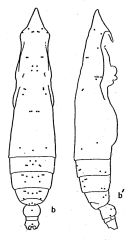 issued from : A. Fleminger in Fishery Bull. natn. Ocean. Atmos. Adm., 1973, 71 (4). [p.985, Fig.9]. As Eucalanus longiceps. Female: b, habitus (dorsal), b', idem (lateral right side).
Dorsal and lateral pattern of integumental organs (black point = sites occuring at 100% frequency, o = 80-99% frequency, x = 10-79% frequency, triangle are sites which are also visible in lateral view but which are assigned to dorsal sets);
|
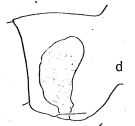 issued from : A. Fleminger in Fishery Bull. natn. Ocean. Atmos. Adm., 1973, 71 (4). [p.968, Fig.1, d (p.969)]. As Eucalanus longiceps. Female: d, genital segment (lateral right side).
|
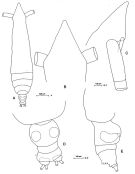 Issued from: M.G. Mazzocchi, G. Zagami, A. Ianora, L. Guglielmo & J. Hure in Atlas of Marine Zooplankton Straits of Magellan. Copepods. L. Guglielmo & A. Ianora (Eds.), 1995. [p.122, Fig.3.19.1]. As Eucalanus longiceps. Female: A, habitus (dorsal); B, C, forehead (dorsal and lateral); D, urosome (dorsal); E, idem (lateral right side). Nota: Proportional lengths of urosomites and furca 54:13:20:13 = 100. Caudal rami very short, more or less as long as wide.
|
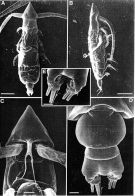 Issued from: M.G. Mazzocchi, G. Zagami, A. Ianora, L. Guglielmo & J. Hure in Atlas of Marine Zooplankton Straits of Magellan. Copepods. L. Guglielmo & A. Ianora (Eds.), 1995. [p.123, Fig.3.19.2]. As Eucalanus longicepsFemale (SEM preparation): A, habitus (dorsal); B, idem (lateral right side); C, forehead and rostral filaments (ventral); D, urosome (dorsal); E, caudal rami (dorsal). Bars: A, B 0.500 mm; C 0.100 mm; D, E 0.050 mm.
|
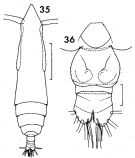 issued from : F.C. Ramirez in Contr. Inst. Biol. mar., Buenos Aires, 1969, 98. [p.42, Lam. VI, figs.35, 36]. As Eucalanus longiceps. Female (from off Mar del Plata): 36, urosome (ventral). Juvenil: 35, habitus (dorsal). Scale bars in mm: 1 (35); 0.2 (36).
|
 issued from : J.M. Bradford in Mem. N. Z. Oceonogr. Inst., 1972, 54. [p.35, Fig.5 (1-3)]. As Eucalanus longiceps. Female (from Kaikoura, New Zealand): 1, habitus (dorsal); . Male: 2, habitus (dorsal); 3, P5. Scale bars: 1 mm (1, 2); 0.1 mm (3).
|
 Issued from : V.N. Andronov in Russian Acad. Sci. P.P. Shirshov Inst. Oceanol. Atlantic Branch, Kaliningrad, 2014. [p.44, Fig.12, 6]. Subeucalanus longiceps after Bradford-Grieve, 1994. Female P1.
|
 Issued from : V.N. Andronov in Russian Acad. Sci. P.P. Shirshov Inst. Oceanol. Atlantic Branch, Kaliningrad, 2014. [p.89, Fig.23: 4]. Subeucalanus longiceps after Bradford-Grieve, 1994. Mxp male.
|
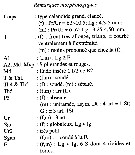 Issued from : C. Razouls in Ann. Inst. océanogr., Paris, 1994, 70 (1). [p.38]. Caractéristique morphologiques de Subeucalanus longiceps femelle et mâle adultes. As Eucalanus longiceps. Terminologie et abbréviations: voir à Calanus propinquus.
| | | | | Compl. Ref.: | | | Razouls & al., 2000 (p.343, tab. 3, Appendix); Berasategui & al., 2005 (p.313, fig.2); ; Dias & Araujo, 2006 (p.46, Rem., chart); Ward & al., 2008 (p.241, Tabls, Appendix II ); Park & Ferrari, 2009 (p.143, Table 2, Appendix 1, biogeography from Southern Ocean); C.E. Morales & al., 2010 (p.158, Table 1); Hidalgo & al., 2010 (p.2089, Table 2); Goetze & Ohman, 2010 (p.2110, Table 1, biogeography); Dias & al., 2010 (p.230, Table 1); Thompson G.A. & al., 2012 (p.127, Table 2, 3); Ward & al., 2014 (p.305, Table 4, abundance in the ''Discovery'' Investigations in the 1930s); Bonecker & a., 2014 (p.445, Table II: frequency, horizontal & vertical distributions); Acha & al., 2020 (p.1, Table 3: occurrence % vs ecoregions, Table 5: indicator ecoregions). | | | | NZ: | 8 | | |
|
Distribution map of Subeucalanus longiceps by geographical zones
|
| | | | | | | | | 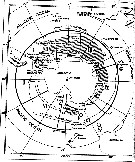 issued from : W. Vervoort in B.A.N.Z. Antarctic Reseach Expedition, Reports - Ser. B, Vol. III, 1957 [Fig.8]. As Eucalanus longiceps. issued from : W. Vervoort in B.A.N.Z. Antarctic Reseach Expedition, Reports - Ser. B, Vol. III, 1957 [Fig.8]. As Eucalanus longiceps.
Chart showing the geographical distribution (white circle) in the seas surrounding the Antarctic continent.
Nota: In this chart the area frequented by whaling vessels has been hatched. The Antarctic circle (66°.5 S) has been drawn as a broken line. The numbers I to VI refer to the sectors into which the Antarctic seas are divided according to Mackintosh (1942) (after Vervoort, 1951). |
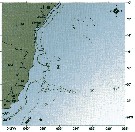 issued from : C. de O. Dias & A.V. Araujo in Atlas Zoopl. reg. central da Zona Econ. exclus. brasileira, S.L. Costa Bonecker (Edit), 2006, Série Livros 21. [p.47]. issued from : C. de O. Dias & A.V. Araujo in Atlas Zoopl. reg. central da Zona Econ. exclus. brasileira, S.L. Costa Bonecker (Edit), 2006, Série Livros 21. [p.47].
Chart of occurrence in Brazilian waters (sampling between 22°-23° S).
Nota: sampling only 1 specimen. |
 Issued from : A. Atkinson & J.D. Sinclair in Polar Biol., 2000, 23. [p.50, Fig.3] Issued from : A. Atkinson & J.D. Sinclair in Polar Biol., 2000, 23. [p.50, Fig.3]
Eucalanus longiceps (= Subeucalanus longiceps) from Scotia Sea.
Median and interquartile ranges of copepods (nos /m2) in the five water zones; from north to south these are SAF Subantractic Front area, PFZ Polar frontal Zone, PF Polar Front area, AZ Antarctic Zone, WSC Weddell-Scotia Confluence area/ East Wind Drift.
Numbers on the plots are upper interquartiles where these could not be scaled. |
| | | | Loc: | | | Antarct. (Amundsen Sea, SW Atlant., Indian, S & SW Pacif., South Georgia, sub-Antarct. (Drake Passage, SW Atlant., off W Prince Edward Is., Indian, SW & SE Pacif.), South Africa (E & W), SW & SE Atlant., Argentina (N-S offshore, off Mar del Plata, off Brazil (off Rio de Janeiro, off Macaé), Sao Tomé, G. of Guinea, ? N Atlant. (in With, 1915, p.52), Indian (Lakshadweep Sea), S Australia, off New Zealand (SW, Kaikoura, SE South Island), S Pacif. (NPFZ), Chile (N & S, Concepcion), Straits of Magellan (Pacific and Central area) | | | | N: | 56 | | | | Lg.: | | | (35) F: 4,8-4,3; (36) F: 5,1-4,21; (116) F: 3,86; M: 3,25; (196) F: 4,9-4,2; M: 3,5-3,33; (254) F ± 5; (391) F: 5-4,43; M: 4,5-4,37; {F: 3,86-5,10} | | | | Rem.: | epipelagic -?. Sampling depth (Antarct., sub-Antarct.) : 0-600 m.
Observed by Dias & al. (2010)) in Intermediate Antarctic water (Brazil).
After Arashkevich (1978) the diets of the species are pennate diatoms (mainly in the gut content), and mess frequent: centric diatoms, flagellates, tintinnids, crustacea, shapeless mass. | | | Last update : 03/04/2020 | |
|
|
 Any use of this site for a publication will be mentioned with the following reference : Any use of this site for a publication will be mentioned with the following reference :
Razouls C., Desreumaux N., Kouwenberg J. and de Bovée F., 2005-2025. - Biodiversity of Marine Planktonic Copepods (morphology, geographical distribution and biological data). Sorbonne University, CNRS. Available at http://copepodes.obs-banyuls.fr/en [Accessed November 29, 2025] © copyright 2005-2025 Sorbonne University, CNRS
|
|
 |
 |

















